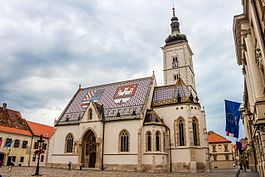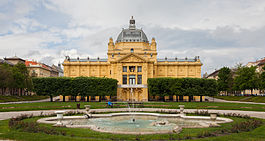City of Zagreb
| Zagreb | ||||||||
|---|---|---|---|---|---|---|---|---|
| City | ||||||||
| City of Zagreb | ||||||||
Counter clockwise from top: St. Mark's Square, Croatian National Theatre, Croatian State Archives, Cibona Tower and HOTO Tower, Zagreb Tram, Art Pavilion.
|
||||||||
|
||||||||
 City of Zagreb within Croatia |
||||||||
| Coordinates: 45°49′N 15°59′E / 45.817°N 15.983°ECoordinates: 45°49′N 15°59′E / 45.817°N 15.983°E | ||||||||
| Country |
|
|||||||
| County |
|
|||||||
| RC diocese | 1094 | |||||||
| Free royal city | 1242 | |||||||
| Unified | 1850 | |||||||
| Subdivisions | 17 city districts (70 settlements) 218 local committees |
|||||||
| Government | ||||||||
| • Type | Mayor-Council | |||||||
| • Mayor | Milan Bandić (MB 365) | |||||||
| • City Assembly | ||||||||
| Area | ||||||||
| • City | 641 km2 (247 sq mi) | |||||||
| • Urban | 162.2 km2 (62.6 sq mi) | |||||||
| • Metro | 3,719 km2 (1,436 sq mi) | |||||||
| Elevation | 158 m (518 ft) | |||||||
| Highest elevation | 1,035 m (3,396 ft) | |||||||
| Lowest elevation | 122 m (400 ft) | |||||||
| Population (2011 census) | ||||||||
| • City | 792,875 | |||||||
| • Estimate (2015) | 799,565 | |||||||
| • Density | 1,200/km2 (3,200/sq mi) | |||||||
| • Urban | 688,163 | |||||||
| • Urban density | 4,200/km2 (11,000/sq mi) | |||||||
| • Metro | 1,113,111 | |||||||
| • Metro density | 300/km2 (780/sq mi) | |||||||
| Time zone | CET (UTC+1) | |||||||
| • Summer (DST) | CEST (UTC+2) | |||||||
| Postal code | HR-10000, HR-10020, HR-10040, HR-10090, HR-10110 | |||||||
| Area code | +385 1 | |||||||
| Vehicle registration | ZG | |||||||
| GDP(nominal) | 2013 | |||||||
| - Total | €15 billion/ USD 20 billion | |||||||
| - Per capita | €18,000/ USD 24,000 | |||||||
| Website | zagreb |
|||||||
Zagreb (Croatian pronunciation: [zǎːɡreb];names in other languages) is the capital and the largest city of Croatia. It is located in the northwest of the country, along the Sava river, at the southern slopes of the Medvednica mountain. Zagreb lies at an elevation of approximately 122 m (400 ft) above sea level. In the last official census of 2011 the population of the City of Zagreb was 792,875. The wider Zagreb metropolitan area includes the City of Zagreb and the separate Zagreb County bringing the total metropolitan area population up to 1,237,887. It is the biggest metropolitan area in Croatia, and the only one with a population of over one million.
Zagreb is a city with a rich history dating from the Roman times to the present day. The oldest settlement located in the vicinity of the city was the Roman Andautonia, in today's Ščitarjevo. The name "Zagreb" is mentioned for the first time in 1094 at the founding of the Zagreb diocese of Kaptol, and Zagreb became a free royal town in 1242, whereas the origin of the name still remains a mystery in spite of several theories. In 1851 Zagreb had its first mayor, Janko Kamauf, and in 1945 it was made the capital of Croatia when the demographic boom and the urban sprawl made the city as it is known today.
Zagreb has a special status in the Croatia's administrative division and is a consolidated city-county (but separated from Zagreb County), and is administratively subdivided into 17 city districts, most of them being at low elevation along the river Sava valley, whereas northern and northeastern city districts, such as Podsljeme and Sesvete districts are situated in the foothills of the Medvednica mountain, making the city's geographical image rather diverse. The city extends over 30 kilometres (19 miles) east-west and around 20 kilometres (12 miles) north-south.
...
Wikipedia








